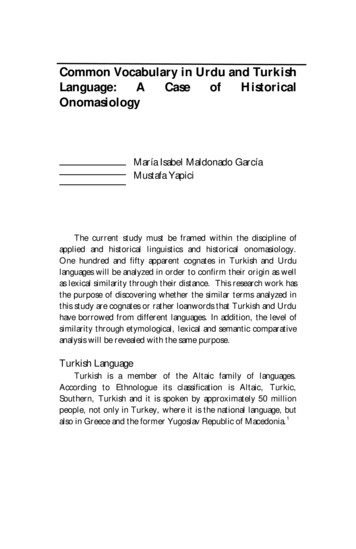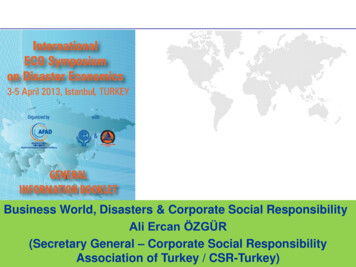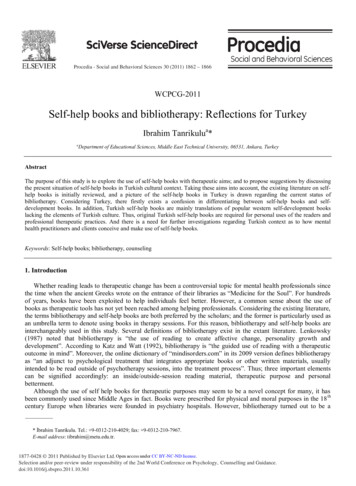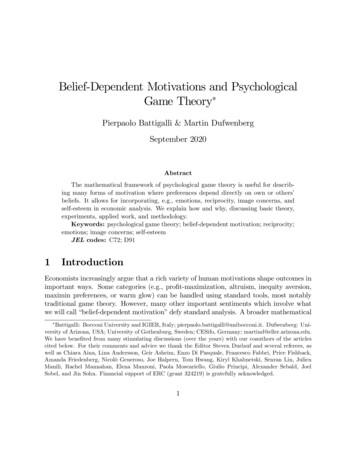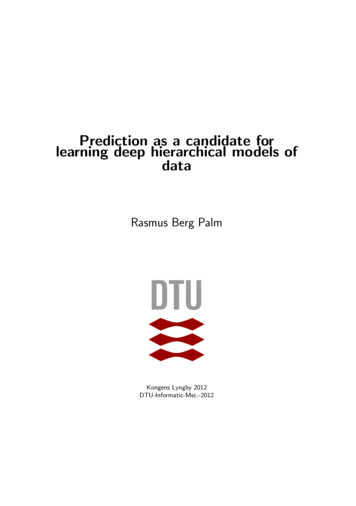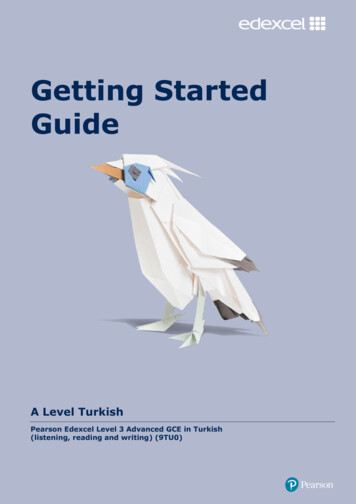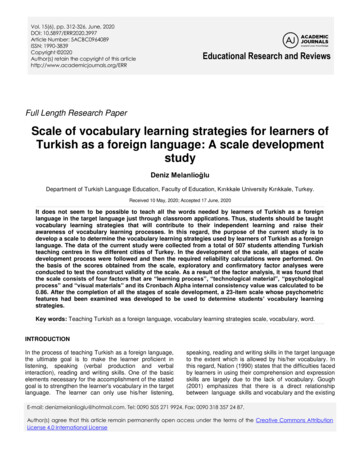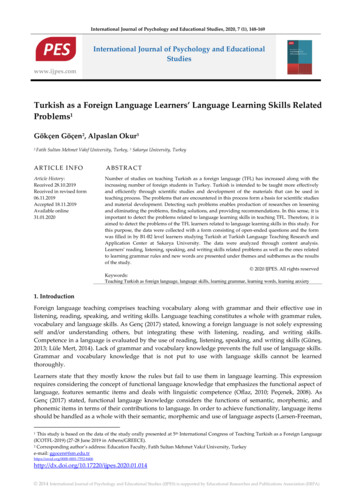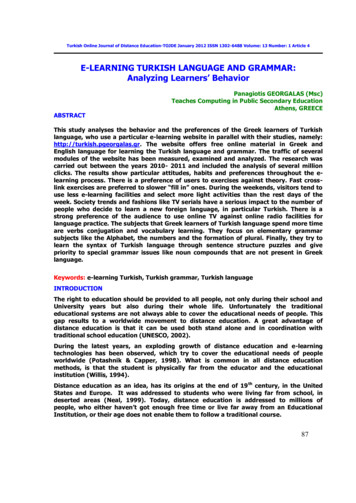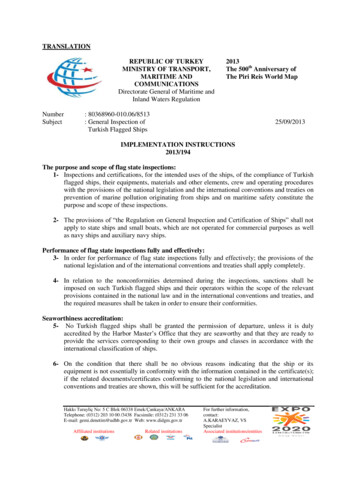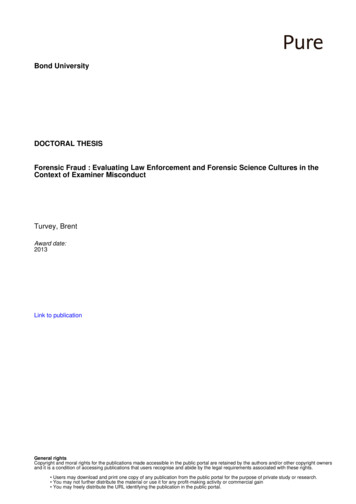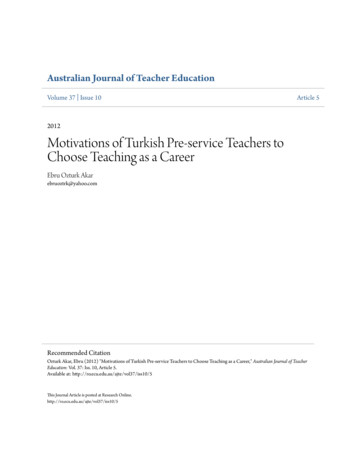
Transcription
Australian Journal of Teacher EducationVolume 37 Issue 10Article 52012Motivations of Turkish Pre-service Teachers toChoose Teaching as a CareerEbru Ozturk Akarebruoztrk@yahoo.comRecommended CitationOzturk Akar, Ebru (2012) "Motivations of Turkish Pre-service Teachers to Choose Teaching as a Career," Australian Journal of TeacherEducation: Vol. 37: Iss. 10, Article 5.Available at: http://ro.ecu.edu.au/ajte/vol37/iss10/5This Journal Article is posted at Research Online.http://ro.ecu.edu.au/ajte/vol37/iss10/5
Australian Journal of Teacher EducationMotivations of Turkish Pre-service Teachers to Choose Teaching as aCareerEbru Ozturk AkarAbant Izzet Baysal UniversityBolu, TurkeyAbstract: This study was conducted to investigate the motivations of974 Turkish pre-service teachers for choosing teaching as a careerand to examine their perceptions about the teaching profession.Correlations, t test, ANCOVAs and MANCOVAs were used to explorethe relationships among participants’ motivations and perceptions,and to make comparisons according to different characteristics suchas gender, different specialism, number of times participants hadentered the university entrance examination, and rank of theirpreference of teaching as a profession. The results showed that thesocial and personal utility value and prior teaching and learningexperiences were the highly rated motivation factors. The findingsalso revealed how the general image of teaching as a career held inthe social-cultural context of Turkish society shaped participants’motivations and perceptions.IntroductionDifferent ways to improve the quality of teaching profession have been explored inmany countries with similar concerns about the development and maintenance of an informedcitizenry (Bruinsma & Jansen, 2010; Krecic & Grmek, 2005; Kyriacou & Benmansour, 1999;Kyriacou, Hultgren, & Stephens, 1999; Richardson & Watt, 2006; Sinclair, Dowson, & McInerney,2006; Yakuub, 1990; Younger, Brindley, Pedder, & Haggar, 2004; Wang &Fwu, 2001). The need toattract talented and motivated people to the teaching profession has been stressed in policydocuments (OECD, 2005). Yet teacher shortage has interfered with these efforts in manyOECD countries due to difficulty in attracting new recruits to teacher education, theresignation of qualified teachers, ageing and retirement of an ongoing teacher labor force(Richardson & Watt, 2006; Sinclair, 2008; Williams & Forgasz, 2009).A substantial amount of research on what initially motivates people to becometeachers reported findings mostly situated within the North American context (Richardson &Watt, 2007; Sinclair, 2008). Current research on motivations to choose teaching profession isrigorously reporting findings from the New Zealand and Australian context (Anthony & Ord,2008; Nuttall, Murray, Seddon & Mitchell, 2006; Richardson & Watt, 2006; Sinclair, 2008;Williams & Forgasz, 2009). Besides, there is a call for large-scale, cross-cultural andlongitudinal studies due to possible presence of commonalities, inadequacy and/orirrelevancy of explanations in different contexts (Nuttall, Murray, Seddon & Mitchell, 2006;Richardson & Watt, 2006). Yet, an integrative theoretical framework is lacking to guide theselection, organization and comparison of influential factors. Rebus sie stantibus, the FITChoice (Factors Influencing Teaching Choice) framework (Richardson & Watt, 2006)provides a comprehensive and coherent model to guide systematic investigation into whypeople choose teaching careers (Anthony & Ord, 2008; Richardson & Watt, 2006).Vol 37, 10, October 201267
Australian Journal of Teacher EducationIn this regard, this study is an attempt to investigate motivations of pre-serviceteachers for choosing teaching as a career and to examine their perceptions about teachingprofession by applying FIT-Choice scale in a Turkish university. Research into Turkishpreservice teachers’ motivation and perceptions with FIT-Choice Scale not only broadens theknowledge base of what motivates individuals in a developing country, but also facilitatescomparison of findings between different contexts.This study also compares participants’ motivation and perceptions as regards theirdifferent characteristics i.e. specialism, the number of times they had entered the universityentrance examination, the rank of their preference of teaching as a profession, and gender. Itwas expected that participants in different groups of specialism and gender, who entered theuniversity entrance exam for once or more, and who ranked teaching profession differently inthis exam would vary in their motivations for choosing a teaching career and perceptions ofthe profession. Identification of these two factors, in addition to exploring the influences oftheir different characteristics on their motivations and perceptions help to identify whyteaching attracts students, and how social and cultural context influence their decisions. Thefindings will also contribute to the teacher education and recruitment efforts in Turkey, whereteacher education has been going through a comprehensive change since 1998 (Eşme, 2009;Grossman, Onkol, Sands, 2007), yet teacher shortages and retention problems persist.FIT-Choice FrameworkFIT–Choice framework is a valid and reliable model to guide the investigation of thequestion “why people choose a teaching career”, (Richardson & Watt, 2006). Richardson andWatt ground their framework on the expectancy-value theory of achievement motivation(Wigfield & Eccles, 2000) which explains that future goals play a motivational role inindividuals’ present steps as a function of their expectancies and values that are linked tothose goals (Wigfield & Eccles, 2000). Watt and Richardson (2007) draw together recurringthemes from the teacher education literature alongside ability related beliefs emphasized inthe career-choice literature and locate these themes within the expectancy-value frameworki.e. “Prior Teaching and Learning Experiences” and “Social Influences” emphasize thepositive influences of prior teaching and learning experiences as well as the influences ofsignificant others such as family members, friends and colleagues. Another construct “SocialDissuasion” is used to determine the extent to which others have dissuaded individuals froma teaching career. These are followed by more proximal influences of “Task Perceptions”,“Self Perceptions”, “Values” and “Fallback Career”. “Task perceptions” exploreindividuals’ perceptions of teaching as a highly demanding career, social status, teachermorale, and salary. “Self-perceptions of ability” explore individuals’ perceptions of their ownteaching abilities. “Values” comprise “intrinsic career value”, “personal utility value” (jobsecurity, time for family, job transferability) and “social utility value” (Shaping future ofchildren/adolescents). “Fallback career” refers to the possibility of people who reluctantlyhave chosen teaching. They may have chosen teaching for reasons relating to not beingaccepted to their major program of choice or being unsure of the actual career they wished topursue.The FIT-Choice scale consists of 18 factors i.e. 12 motivation factors, 5 beliefs aboutthe profession factors, and 1 career choice satisfaction factor (Watt & Richardson, 2007). Themotivation factors are ability, intrinsic career value, fallback career, job security, time forfamily, job transferability, shaping future of children/adolescents, enhancing social equity,making social contribution, working with children/adolescents, prior teaching and learningexperiences, and social influences. All the motivation factors contain 3 items each, except theVol 37, 10, October 201268
Australian Journal of Teacher Educationtime for family factor, which contains 5 items. Seven-point Likert type response format isused i.e. 1 (not at all important) to 7 (extremely important). ‘I chose to become a teacherbecause .’ is the preface to all motivation items. The beliefs about teaching factors areexpertise (3 items), difficulty (3 items), social status (6 items), salary (2 items), and socialdissuasion (3 items) with possible responses from 1 (not at all) to 7 (extremely). Careerchoice satisfaction factor contains 3 items with possible responses ranging from 1 (not at all)to 7 (extremely). FIT-Choice Scale also includes an initial open-ended question of “what areyour main reasons for choosing to become a teacher”.Conceptual FrameworkSince the early 1990s, research on motivations for teaching has been underpinned bydifferent theoretical bases and used a variety of research methods, such as interviews,questionnaires and case studies. Similar but not identical motivations synthesized from thesestudies include a “love” of or desire to work with and be beneficial for students, altruism oraiming to make a difference in communities and society, and the influence of othersincluding family members, past teachers or members of the wider community. Perceivedbenefits, and/or convenience of teaching such as work schedules, work hours, vacations,career security and salary, a “calling” to teach and a love of teaching or particular subject, ora desire to impart knowledge are also among the major motivations to choose teaching as aprofession. The nature of teaching work, the perceived ease of entry into initial teachereducation courses, and the status teaching provides are also identified in the previous researchas reasons to choose this career (Sinclair. 2008).Sinclair’s (2008) research with 211 Australian student teachers extends the findings ofearlier studies that teaching attracts people because it provides an opportunity for workingwith children. Teaching also provides intellectual stimulation, personal and professionaldevelopment. The nature of teaching work, perceived working conditions and life-fit areother attractors of teaching as a profession. Williams and Forgasz’s (2009) findings from astudy of motivations of 375 career change students support the research that people choseteaching as a career primarily for intrinsic or altruistic reasons rather than for extrinsicrewards such as pay, working conditions, career opportunities or status.Manuel and Hughes (2006) reported the quest for personal fulfillment, the desire to workwith young people to make a difference in their lives, and the opportunity to continue meaningfulengagement with the subject of their choice as fundamental reasons for people to choose teachingat the end of research with 79 secondary teacher education students in Australia. Anthony andOrd (2008) report push and pull factors, family experiences, values and task expectancies asthe reasons of 68 participants to pursue teaching in New Zealand. Bruinsma and Jansen(2010) extend the concept of motivation to become a teacher by making a distinction betweenadaptive and maladaptive motives based on research into achievement motivation and thestudies by Sinclair, Dowson and McInerney (2006) and Martin (2006).Recent studies which have explored Turkish pre-service teachers’ motivations forteaching show that intrinsic career value, salary, social status, social influences, working withchildren/adolescents, and making a social contribution are major reasons for choosingteaching as a career (Boz & Boz, 2008). Ok and Önkol (2007) also listed love of the subjectarea, having good job opportunities, helping others, working with children, and perceivedpersonal suitability. Aksu, Engin-Demir, Daloğlu, Yıldırım and Kiraz (2010) reported thatmore than half of the 18,226 pre service teachers from 51 Faculties of Education in theirstudy had willingly chosen teaching. The other reasons listed were flexible working hours,holidays and the possibility of engaging in secondary employment. Low university entranceVol 37, 10, October 201269
Australian Journal of Teacher Educationexam scores (29%), opportunity to find a job easily (25%) and good working conditions(21%) were also nominated by pre-service teachers as reasons to choose teaching as aprofession (Aksu et al., 2010). Aksu et al. (2010) reported that only 9% of the pre serviceteachers mentioned the status of teaching profession in the Turkish society as a reason ontheir choice.Job security has been identified as another significant reason for increased demand forteacher education programs in the Turkish context (Aksu et al., 2010; Aydın & Baskan,2005). Scholarships provided by the Ministry of National Education to those selectingteaching programs is yet another reason for the considerable increases in numbers selectingteaching in recent years (Semerci & Taşpınar, 2003). However, Gürbüztürk (2004) andÖzbek (2007) reported that pre-service teachers’ personal reasons for choosing theprofession, such as regarding teaching as an ideal or sacred, and respected profession, andlove of children, were stronger influences than economic and social reasons on their choice.The examination system also plays a significant role in the choice of teaching as aprofession (Semerci & Taşpınar, 2003). Although some students willingly choose teachereducation, a considerable number of teacher candidates enroll on programs because of theirlow university entrance exam scores. These teacher candidates are said to be less motivatedbecause teaching was not their primary career choice, and they would have chosen a differentfaculty had their exam scores been higher (Aksu et al., 2010).Teacher Shortage and RetentionPeriodic teacher shortages have been experienced in Turkey due to a demographicpressure on the teacher education system (Yıldırım & Ok, 2002). Teacher shortage was aproblem at the lower and upper secondary school levels in the 1960s, and there were subjectarea teacher shortages in the 1970s. The lengthening of teacher education programs in theearly 1980s also resulted in a teacher shortage, and the large-scale retirement among teachersdue to an early retirement law added to the problem of shortages in the early 1990s (Yıldırım& Ok, 2002). Furthermore, the introduction of eight years of compulsory primary educationin 1997 also resulted in teacher shortage (Güven, 2008).During the periods of teacher shortages, graduates of other educational organizationswere hired as teachers. Teacher education and recruitment policies ignored qualityrequirements to overcome teacher shortage. Most recently in 1998, the Ministry of Educationrecruited more than 20,000 university graduates, either with or without a teaching certificate,at elementary schools to meet the teacher demand. Student numbers in Education Facultiesrapidly increased and the teacher education system became overloaded in the early 2000s.These short term attempts in turn led to teacher demoralization (Güven, 2008), damaged thesocial status of teaching profession in the Turkish society, and fostered a view of teaching asthe profession of those who were not able to find other jobs (Semerci & Taşpınar, 2003).Today, teacher shortages and retention are still major problems in Eastern Turkey and villageschools. New graduates who do not want to serve in these economically underdevelopedplaces, which do not offer much of a social life for teachers, request a reassignment after oneyear of teaching (Yıldırım & Ok, 2002).Vol 37, 10, October 201270
Australian Journal of Teacher EducationMethodSample and SettingThe study was conducted in a state university established in 1992. There are 9departments in the Education Faculty; Computer Education and Instructional Technology,Educational Sciences, Elementary Education, English Language Teaching, SecondaryScience and Mathematics Education, Secondary Social Sciences Education, TurkishLanguage Teaching, Art Education and Special Education. The sample consisted of 974students from Elementary Education, English Language Teaching, and Art Teaching. A fewfrom the secondary school science and mathematics teaching also participated. As seen inTable 1, majority of the participants were female, younger than the age of 20 and had enteredthe university entrance examination only once. The teaching profession had been the firstpreference for 16.1% of tmentEE Science TeachingEE Social Sciences TeachingEE Mathematics TeachingEE School teachingEnglish Language TeachingArt TeachingEE Preschool teachingSS Science-Mathematics 48279Age 20 years old21-25 years old 2664.134.21.760532316Once53.5503TwiceThree timesFour times and 185Number of timesentrance exam satuniversityTeaching as a careerFirst choice2-5th choice6-10th choice11-15th choice16th and higherTable 1: Summary of Participant CharacteristicsProcedure and MaterialsBased on the survey method, FIT-Choice scale was used to assess the factorsinfluencing participants’ choice of the teaching profession. The translation-back-translationof the original FIT-Choice scale, and meaning check was done by a team of four involvingthe researcher, a native English speaker and two bilingual English language teachers. FITChoice scale was administered by the researcher with informed consent of chairpersons of thedepartments in the Fall semester of 2010-2011. Through convenience sampling, 1147 preservice teachers in class groups were invited to participate in the study in which the responseVol 37, 10, October 201271
Australian Journal of Teacher Educationrate was 85% in total. The participants were informed about the study and were requested toindicate their age, gender, and department, rank of their preference of teaching as aprofession, and specify how many times they had entered the university entranceexamination. The sample represents 25% of all students enrolled in the Faculty. Including theinitial open-ended question of “what are your main reasons for choosing to become ateacher”, the FIT-Choice Scale employed in this study contained 63 items (See Table 2 for allfactors and items from Watt and Richardson (2007)).Data AnalysisDescriptive statistics (means and percentages), and inferential statistics (factoranalysis, Pearson correlations, T-test, ANCOVA and MANCOVA) were used to examinepre-service teachers’ motivations for choosing teaching as a career and differences as regardsgender, specialism, number of times university entrance exam sat and ranking of teaching asa career choice in this exam. Qualitative data were included to make additional inferencesabout participants’ motivation in choosing teaching.Two separate Confirmatory Factor Analyses (CFA) were conducted by using LISREL8.30 (Jöreskog & Sörbom, 1999) to check if the 18-factor FIT-Choice model with 12motivation factors, 5 perception factors and one career choice satisfaction factor would beconfirmed in the present sample i.e. if FIT-Choice scale yields reliable and valid scores in theTurkish context. In order to assess the data fit, X2/df ratio ( 5), Root Mean Square Error ofApproximation (RMSEA) ( .08), and Comparative Fit Index (CFI) ( .90) were used(Jöreskog & Sörborn, 1993; Kline, 2005).Mean scores on each factor were used to conclude about the participants’ motivationsfor choosing teaching as a career, perceptions about the teaching profession and career choicesatisfaction. It was expected that participants who scored higher in motivations for teachingwould also score higher in perceptions about the profession (Hypothesis 1a). It is alsoexpected that the participants’ scores of motivation for teaching and perceptions aboutprofession correlate with the number of times they entered the university entrance exam andrank of teaching in their list of profession (Hypothesis 1b). Therefore, Pearson correlationsamong motivations, perceptions, number of times the university examination was sat, andranking of teaching as a profession in this exam were computed.It is also expected that male participants would score higher on social dissuasion thanfemale participants (Hypothesis 2) as teaching is perceived to be the most suitable professionfor women in the Turkish society (Güven, 2008). Independent sample T-test tested forstatistically significant differences by participants’ gender.Factor means as regards different specialism were compared using MANCOVAs tosee the possible effects of participant characteristics (specialism, number of times theuniversity examination was sat, and ranking of teaching as a profession in this exam) on theFIT-Choice subscales. It was expected that participants enrolled in different teachingprograms would have different scores of motivation for teaching and perception about theprofession, and the number of times they entered the university entrance exam and the rank ofteaching in their list of profession would influence these scores (Hypothesis 3). Pre-serviceteachers’ specialism was entered as an independent variable whereas the number of times theuniversity examination was sat, and ranking of teaching as a profession in this exam wereentered as covariates and their motivation for teaching and perceptions about the professionwere entered as dependent variable. A series of univariate analyses were also conducted toinvestigate the univariate effects of specialism on the motivations for teaching andperceptions about the profession after MANCOVAs. Partial η2 coefficients were used toVol 37, 10, October 201272
Australian Journal of Teacher Educationexamine the results i.e. partial eta squares less than and equal to .06 were treated as small andunimportant coefficients to explain the dependence of participants’ motivation andperceptions about the teaching profession on their specialism.Content analysis of the participants’ responses to the initial open ended question wasconducted by a team of two involving the researcher and a research assistant through thecoding and thematizing of the raw data, generating matrices (Miles & Huberman, 1994),identification and grouping of similarities and differences in responses, development ofinvariant themes (Patton, 1990), drawing a pattern of responses, and making inferences andgeneralizations where inter-coder reliability was 90%.ResultsPreliminary analysesCFA of Theoretical and Analytical ModelResults of the first CFA for the 12 motivation factors demonstrated acceptable fit tothe data X2/df 4.65; RMSEA 0.063; CFI 0.88. Internal reliability of the subscales rangedfrom 0.55 to 0.89. The results of the second CFA for the 6 perception factors had no fit to thedata X2/df 5; RMSEA 0.12; CFI 0.83. When the items C7 “Do you think teaching isemotionally demanding?”, D1 “How carefully have you thought about becoming a teacher?”and D2 “Were you encouraged to pursue careers other than teaching” were excluded from theanalysis, that they did not fit with the other items of the “Difficulty”, “Dissuasion” and“Satisfaction with Choice” subscales; thus fit indices improved (X2/df 5.49; RMSEA 0.068;CFI 0.916). Internal reliability of the factors, items and their parameter estimations arepresented in Table 2. Standardized parameter estimations ranged from .27 to .92, whichshowed that the items were significantly predicted by their factors in the FIT-Choice Scale.FactorsAbility (α .83; Item mean 5.12)B 34 Teaching is a career suited to my abilitiesB 18 I have good teaching skillsB 5 I have the qualities of a good rinsic career value (α .86, Item mean 5.10)B 1 I am interested in teachingB 12 I like teachingB 7 I have always wanted to be a teacher.83.82.77.20.19.32.78.78.65Fallback career (α .62, Item mean 2.73)B 48 I chose teaching as a last resort careerB 35I was not accepted to my first-choice careerB 11 I was unsure of what career I wanted.63.51.44.32.52.65.55.33.23Job security (α .64, Item mean 4.99)B 38Teaching will be a secure jobB 27 Teaching will provide a reliable incomeB 14 Teaching will offer a steady career 68.54.47.63.51.44Time for family (α .81, Item mean 5.14)B 29School holidays will fit in with family commitmentsB 18As a teacher I will have a short working dayB 16Teaching hours will fit with the responsibilities of having afamilyB4 As a teacher I will have lengthy holidaysVol 37, 10, October 201273
Australian Journal of Teacher EducationB2 Part-time teaching could allow more family time.55.60.33Job transferability (α .55, Item mean 5.11)B 45A teaching job will allow met o choose where I wish to liveB22 A teaching qualification is recognised everywhereB8 Teaching will be a useful job form e to have when .51.09.10.09.06.07.10.85.05.10Shape future of children/adolescents (α .73, Item mean 5.82)B 9 Teaching will allow me to shape child/adolescent valuesB 53 Teaching will allow me to have an impact onchildren/adolescentsB 23 Teaching will allow me to influence the next generationEnhance social equity (α .74, Item mean 5.21)B 54Teaching will allow me to work against social disadvantageB 36Teaching will allow me to raise the ambitions ofunderprivileged youthB 49Teaching will allow me to benefit the sociallydisadvantagedMake social contribution (α .79, Item mean 6.23)B 31 Teaching enables met o ‘give back’ to societyB 6 Teaching allows me to provide a service to societyB 20 Teachers make a worthwhile social contributionWork with children/adolescents (α .89, Item mean 4.85)B 26 I want to work in a child/adolescent centred environmentB 37 I like working with children/adolescentsB 13 I want a job that involves working withchildren/adolescentsPrior teaching and learning experiences (α .74, Itemmean 5.11)B 30 I have had good teachers as role-modelsB 17 I have had inspirational teachersB 39 I have had positive learning experiencesSocial influences (α .79, Item mean 4.39)B 40People I’ve worked with think I should become a teacherB 3 My friends think I should become a teacherB 24 My family think I should become a teacherSalary (α .76, Item mean 2.70)C 1 Do you think teaching is well paid?C 3 Do you think teachers earn a good salary?Social status (α .82, Item mean 4.44)C 12 Do you believe teaching is a well-respected career?C 9 Do you think teachers feel valued by society?C 13 Do you think teachers feel their occupation has high socialstatus?C 5 Do you think teachers have high morale?C 4 Do you believe teachers are perceived as professionals?C 8 Do you believe teaching is perceived as a high-statusoccupation?Expertise (α .82, Item mean 5.47)C 15 Do you think teachers need highly specialised knowledge?Vol 37, 10, October 201274
Australian Journal of Teacher EducationC 14 Do you think teachers need high levels of technicalknowledge?C 10 Do you think teaching requires high levels of expertknowledge?Difficulty (α .61, Item mean 5.51)C 2 Do you think teachers have a heavy workload?C 11 Do you think teaching is hard work?Satisfaction (α .89, Item mean 5.25)D 5 How happy are you with your decision to become a teacher?D 3How satisfied are you with your choice of becoming 2.09.12.10.10Social dissuasion (α .41, Item mean 4.27)D 6 Did others influence you to consider careers other than.53.19.10teaching?D 4 Did others tell you teaching was not a good career choice.49.20.10Note: P.E.: Parameter Estimations, S.E.: Standard Error, E.M.E.: Estimated Measurement ErrorTable 2: Summary of the Confirmatory Factor Analysis for the Factors Influencing Teaching ChoiceSubscalesCorrelation AnalysisTable 3 presents the relationships among all factors. Confirming Hypothesis 1a,relationships among one of the motivation factors and career choice satisfaction factor i.e.intrinsic career value and career choice satisfaction (r .77), and two perception factors i.e.difficulty and expertise (r .70) were strong. Relationships among motivation factors weremoderate to strong on the basis of .30 criterion such as the relationships between intrinsiccareer value and ability (r .64), enhancing social equity and shaping the future of childrenand adolescents (r .62), and fallback career and intrinsic career value (r .52), (See Table 3for the correlations among all factors). On the other hand, the findings did not confirmHypothesis 1b. The relationships of less than .30 suggested that the number of timesparticipants had entered the university entrance examination and ranking of their preferenceof teaching as a profession in this exam did not considerably relate to their motivation inchoosing teaching and perceptions about the profession.Vol 37, 10, October 201275
Australian Journal of Teacher EducationVariableAbilityIntrinsic careervalueFallback careerJob securityTime for familyJobtransferabilityShape future ofc/aEnhance socialequityMake socialcontributionWork withchildren/adolescentsPrior icultySocial statusSalarySocialdissuasionSatisfactionwith choiceAgeChoiceNumber oftimes uni.ex. 0.
Ebru Ozturk Akar Abant Izzet Baysal University Bolu, Turkey Abstract: This study was conducted to investigate the motivations of 974 Turkish pre-service teachers for choosing teaching as a career and to examine their perceptions about the teaching profession. Correlations, t test, ANCOVAs and MANCOVAs were used to explore
